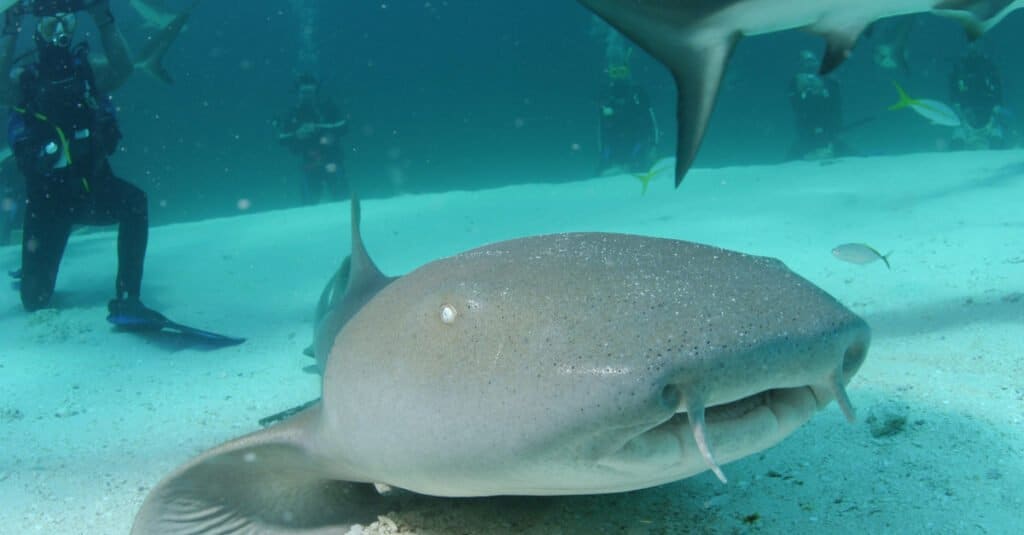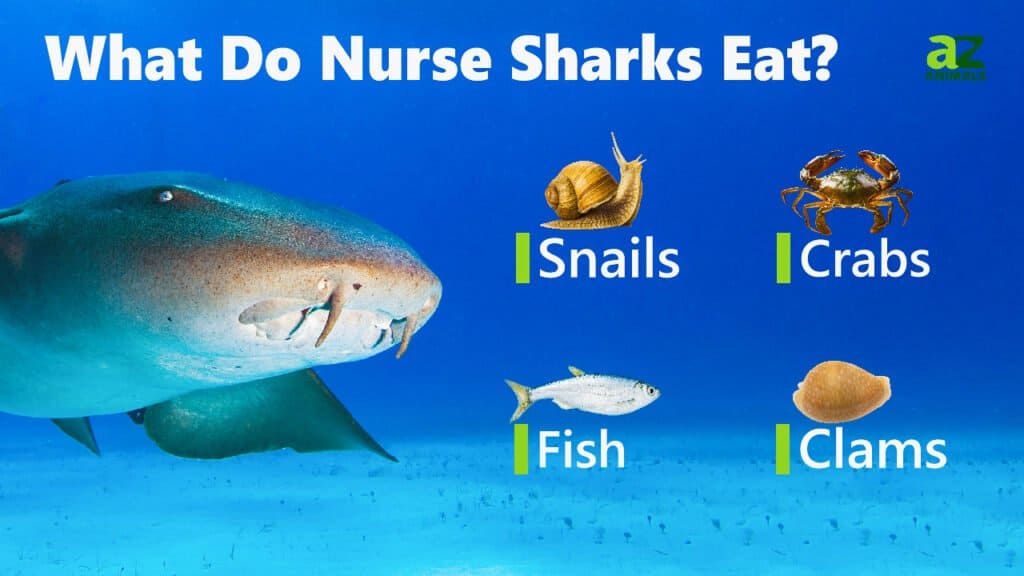Sharks have earned the reputation of savage, aggressive hunters due to their voracious appetites that often feed on huge sea animals. They are also known for their ruthless strategy of devouring their prey using hundreds of needle-sharp teeth in their mouths. This representation may be true for most sharks, but not for all of them. Many shark species are not aggressive, and that includes nurse sharks. Nurse sharks often inhabit warm, coastal waters across Central America, but they pose no threat to people unless disturbed or provoked. Nurse shark teeth do not look like most shark species, as they are not designed to grip and tear flesh. Instead, the nurse shark’s teeth are uniquely built for its specific diet.
Nurse sharks have a friendlier facade, unlike many aggressive shark species you are familiar with. Their smiles are not as frightening as most sharks, and they do not have long, needle-sharp teeth that easily pierce through the flesh of their poor victims. Nurse sharks often eat clams and crustaceans, which make the sight of them eating their prey less vicious. Nurse sharks are peaceful and passive; they often lie at the bottom of shallow coastal waters, sucking food as they paddle along the ocean bed, almost as if they are walking. Sometimes dubbed as the couch potatoes of the sea, nurse sharks rarely attack or bite, but when provoked or startled, they can bite in self-defense.
What Do Nurse Shark Teeth Look Like?

Nurse sharks have rows of tiny, serrated teeth that are different from other shark species.
©tali de pablos/Shutterstock.com
Nurse sharks have quite a different dental structure compared to other shark species. A nurse shark’s mouth possesses rows of tiny, serrated teeth that are not designed to pierce through thick flesh but to crush hard-shelled crustaceans and snails. Unlike mammals with various teeth types in one mouth, nurse sharks only have one type of tooth, but they have a number of them, making the set of teeth deliver their purpose effectively.
Whenever we think about shark teeth, the first thing that comes up is the common killer teeth of great white sharks. Great white sharks have that kind of dentition because of their diet. Consequently, nurse sharks’ teeth align with their diet as well. Nurse sharks are more fond of smaller prey and hard-shelled food. Because of this diet, their teeth are designed specifically to crush hard shells efficiently.
Nurse sharks, Ginglymostoma cirratum, have single rows of small, jagged teeth lining both their upper and lower jaws. These teeth have sharp and pointed edges decorated by accessory cusps at each side.
Nurse sharks are slow-moving and huge – they can measure up to 14 feet long. However, despite their seemingly terrifying appearance, their behavior says otherwise. Even though nurse sharks love the warmth of shallow coastal waters, they rarely cross paths with humans, and when they do, they are completely harmless. Divers are even observed passing along or swimming above them without noticing them on the ocean floor. Nurse sharks can sleep too, and their unmoving bodies laying low on the seafloor makes them more unnoticeable.
How Many Teeth Do Nurse Sharks Have?

A nurse shark has about 58 to 76 teeth.
©frantisekhojdysz/Shutterstock.com
Unlike most shark species equipped with over 300 needle-sharp teeth, nurse sharks only have 58 to 76 teeth inside their mouth. They have about 30 to 42 teeth attached to their upper jaw and 28 to 34 teeth protruding from the lower mandible. All these teeth have the same shape, appearance, usage, and almost the same size.
As the nurse shark opens its mouth, the front of the lower jaw will visibly sport three rows of teeth. These teeth are serrated to help nurse sharks grasp their prey and are strong enough to crush their shelled food.
If you take a look at a nurse shark’s skull, you will find multiple other teeth, sometimes reaching thousands, lined along its jaws. These teeth do not show inside its mouth all at once. Like any other shark species, nurse sharks are polyphyodont, which means their teeth continue to shed and are continuously replaced throughout their lifetime. Once any of the nurse shark’s serrated teeth falls out, another tooth erupts in its place. However, contrary to popular belief that sharks regrow their teeth, they do not. Nurse sharks have multiple teeth lining up their jaws, but only 58 to 76 of them show up at a time. Once a tooth falls out, one of the teeth located inside multiple rows of teeth in their jaws erupts to replace the old one.
What Do Nurse Sharks Use Their Teeth For?

Nurse sharks have quite a different diet than most shark species. They prefer smaller, tougher prey than fleshy marine animals like dolphins and sea lions. Their multiple serrated teeth work together with their strong jaws to crush the shells of crustaceans, clams, snails, and other shellfish.
The strong jaws of nurse sharks are often utilized in crushing and grinding tough-shelled food, even bivalves and corals. However, many nurse sharks prefer softer prey such as fish, shrimp, and squid. Nurse sharks eat by capturing their prey through suctions as they hover over the seabed. Their pectoral fins touch the seafloor as they cruise across it, creating the illusion that they are “walking.” As they do this, they vacuum the seabed for crustaceans, snails, clams, or teleosts and capture by grasping and crushing them before swallowing.
Do Nurse Sharks Bite Humans?
Luckily for humans, nurse sharks are one of the least aggressive sharks. However, even though they do not initiate attacks on humans, nurse sharks are not friendly or docile either, so swimming close to them or even touching them can trigger their self-defense and lead them to bite. They often dwell at the bottom of shallow seawater and do not interact with humans. But if they feel threatened, bothered, or stepped on, these sharks can bite. Their bite may be less painful than other sharks, but they can still leave a swimmer or a diver injured because of their powerful jaws.
The photo featured at the top of this post is © frantisekhojdysz/Shutterstock.com
Thank you for reading! Have some feedback for us? Contact the AZ Animals editorial team.







